
THEORY WORKSHOP
HELMUT ZETTL
Tiahuanaco and the Deluge

THEORY WORKSHOP
HELMUT ZETTL
Tiahuanaco and the Deluge
Cradled
in the basin of the Peruvian-Bolivian altiplano, the
Titicaca region is currently densely
populated by the Aymara Indians,
who eke out an agricultural existence,
subsisting primarily on maize,
frozen potatoes, and chicha, a
fermented alcoholic beverage made of
cornmeal.
But there is evidence that such was not always the case. Just
12 miles southward of the southernmost
tip of Lake Titicaca lie the
remains of Tiahuanaco, the
site of a technologically advanced culture
considered by many archaeologists
(romantic not orthodox) to be the oldest
ruins in the world. Although some
misguided scholars have attributed the
buildings of Tiahuanaco to
the Incas, it has now been established that
the city was already in ruins
when the first Incas came upon the scene.
In 1540 the Spanish chronicler,
Pedro Cieza de Leon, visited
the area and his description of
the statues and monoliths compares very
closely to what we see today. The
site is at an altitude of 13,300 feet,
which places it some 800
feet above the present level of Lake Titicaca.
Most archaeologists agree that
in the distant past Tiahuanaco was a
flourishing port at the edge of
the lake, which means that the water has
receded almost 12 miles and
has dropped about 800 feet since then. All
concur that the lake is shrinking,
due mainly to evaporation, since no
rivers flow from it.
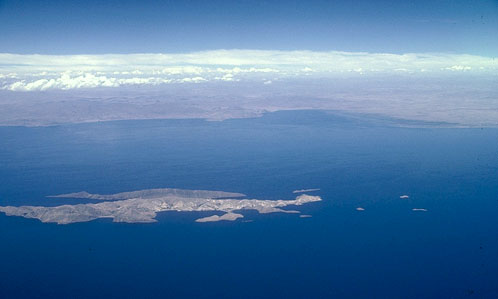
The Tiahuanaco culture, as
it is called, is unique in its sculpture
and its style of stone construction.
The figures depicted in the statuary
have a rather square head with
some covering like a helmet; they have
square eyes and a rectangular mouth.
The stone works at the ruins consist
of such structures as the Gate
of the Sun, a portal carved from a single
block of stone weighing 15 tons.
The stone steps of the Kalasasaya, each
of which is a rectangular block
of stone about 30 feet wide; the so-called
"idols," which are giant about
23 feet tall representatives of unusual
looking beings with typical
Tiahuanaco head and trace; and the enormous
monolithic stone blocks,
many of which appear to have been cast rather
than carved, are some of these
unusual features.
At the area called Puma Punku,
which is about 1 mile distant from
the principal part of the
ruins, the gigantic stones are bluish-gray in
color and appear to have
been "machined," and they have a metallic ring
when tapped by a rock. There is
also a reddish "rust" or oxidation covering
many of the stones. Many
of these enormous stone blocks probably have not
been moved since they fell
thousands of years ago. Archaeologists however
speculate that the stones
were dressed, but never erected that the
construction for which they were
intended was interrupted. It is equally
valid, however, to assume
that the buildings were completed and then
toppled by some natural catastrophe,
such as the eruption of the Andes
mountain chain or a world-wide
deluge.
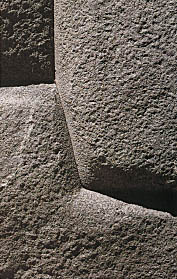
It is interesting to observe
the archaeological excavation work,
which is under way at the site.
At this altitude of 13,300 feet some of the
remains are found at a level
6 feet below the earth's surface. The mountain
ranges which surround the
area are not high enough to permit sufficient
runoff of water or wind erosion
to have covered the ruins to such a depth.
This remains a mystery.
Legends have persisted over
the centuries that there are stone
structures beneath the waters of
Lake Titicaca, much the same kind as can be
found on the lake's shore.
The Indians of that legion have frequently
recounted this tradition,
but until recently there has been no proof of
such structures. In 1968 Jacques
Cousteau, the French underwater explorer,
took his crew and equipment
there to explore the lake and search for
evidence of underwater construction.
Although severely hampered in their
activities by the extreme altitude,
the divers spent many days searching the
lake bottom, in the vicinity
of the islands of the Sun and Moon, but found
nothing man-made. Cousteau
concluded the legends were a myth.
Recently in November 1980,
however, the well known Bolivian author
and scholar of pre-Columbian cultures,
Hugo Boero Rojo, announced the
finding of archaeological ruins
beneath Lake Titicaca about 15 to 20 meters
below the surface off the
coast of Puerto Acosta, a Bolivian port village
near the Peruvian frontier
on the northeast edge of the lake. Based upon
information furnished by Elias
Mamani. a native of the region who is over
100 years old, Boero Rojo and two
Puerto Ricans cinematographers, Ivan and
Alex Irrizarry, were able to locate
the ruins after extensive exploration of
the lake bottom in the area,
while filming a documentary on the nearby
Indians.
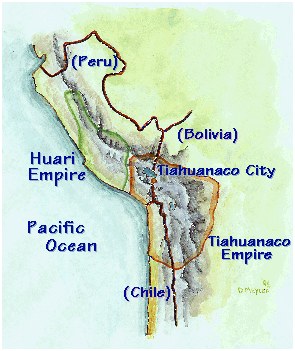
At a press conference the Bolivian author stated "we can now say
that the existence of pre-Columbian
constructions under the waters of Lake
Titicaca is no longer a mere supposition
or science-fiction, but a real fact.
Further,"
he added, 'the remnants found show the existence of old
civilizations that greatly antecede
the Spanish colonization. We have found
temples built of huge blocks of
stone, with stone roads leading to unknown
places and flights of steps whose
bases were lost in the depths of the lake
amid a thick vegetation of
algae." Boero Rojo described these monumental
ruins as being "of probable
Tiahuanaco origin.'
The Polish-born Bolivian archaeologist
Arturo Posnansky has
concluded that the Tiahuanaco culture
began in the region at about 1600 B.C. and flourished until at least
1200 A.D. His disciple, Professor Hans
Schindler-Bellamy, believed Tiahuanaco
to have reached back 12,000 years
before the present era, although
a more conservative Peruvian archaeologist.
Professor Kaufmann-Doihg,
dates the site's flourishing at about 300-900 A.D.
What happened to the advanced
ancient culture, however, has not yet been
determined.
Boero Rojo's discovery nevertheless
may prove to create more problems
than it solves. If, over
the past 3 or 4000 years Lake Titicaca has slowly
receded, as appears to be the case-as
all scientists agree, then how can we
explain the existence of stone
temples, stairways, and roads still under
water'? The only answer is that
they were built before the lake materialized.
We must go back, then, to
the remnants of Tiahuanaco and reexamine the more than 400 acres of ruins,
only 10 percent of which have been excavated.
We have pointed out that dirt covers
the ancient civilization to a depth of
at least 6 feet. The only
explanation for this accumulation is water.
A large amount of water had to have inundated the city; when it
receded it left the silt covering
all evidence of an advanced civilization,
leaving only the largest
statues and monoliths still exposed. It is logical
to conclude, therefore, that
Tiahuanaco was built before the lake was
created, and not as a port on its
shore. As the waters today continue to
recede, we should be able to find
more evidence of the city's remote peoples.
Scientists theorize that
the area ot Lake Titicaca was at one time at sea
level, because of the profusion
of fossilized marine life which can be found
in the region. The area then
lifted with the Andean upheaval and a basin
was created which filled in to
form the lake. No one has suggested the marine
life might have been brought
to the altiplano by sea waters which were at
flood stage.
Peruvian legends clearly relate a story of world-wide flood in the
distant past. Whether it was the
biblical flood of Noah, or another one, we
cannot say, but there is
ample physical evidence of a universal inundation,
with the world-wide deluge described
in more than a hundred flood-myths.
Along with Noah's flood were
the Babylonian Utnapischtim of the Gilgamesh
epic, the Sumerian Ziusudra, the
Persian Jima, the Indian Manu, the Maya
Coxcox, the Colombian Bochica,
the Algonkin's Nanabozu, the Crows' Coyote, the Greek Deukalion and
Pyrrha, the Chinese Noah Kuen, and the Polynesian Tangaloa. It is
evident there was a world-wide deluge 19,000 years ago.
(Global doomsdays are conspicuous in the Hopi Indian legends, the Finnish
Kalevala epic, the Mayan Chilam Balam and Popol Vuh, and in the Aztec
calendar, the last of which predicts that our present civilization will
be
destroyed by "nahuatl Olin" or
"earth movement," that is, devastation by
earthquake. Due to Aztec cyclic
theory this will become the fifth doomsday
after the "death of the Jaguars,"
"the death of the Tempests," "the death of
the Great Fire" (vulcanism),
and "the Great Deluge."
If a flourishing
advanced civilization existed on the Peruvian
altiplano many thousands of years
ago and was reached by the flood waters,
many problems would be solved,
such as the existence of Tiahuanaco's ruins
under 6 feet of earth at an elevation
of 13,300 feet. The presence of stone
structures still under the
lake's waters and the existence of marine life
at an impossible altitude
would also make sense.
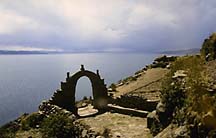
In my 1978 and 1984 trips
to Peru I was impressed by agricultural
terracing on the sides and very
tops of the steep peaks. These appear to be
the oldest—and now unused-portions
of the terracing. As you look down the
mountains you see more and more
terraces of more recent origin. We are told
that only the Inca (specifically
the Sapai Inca, i.e. the ruler) could use
the lower portions and the
fertile valleys; the "peons" had to climb to the
very peaks to cultivate the
soil for their own subsistence. This seems
highly unlikely in what we know
to have been a pure communistic-theocratic
society.
Pondering
the logistics involved, I see no problem with the spring
planting. It would not be difficult
to carry a sack of seed to the mountain
tops, scratch out some of
the soil, and plant them. But then, I wondered,
it must have been very tough in
the fall to carry the harvest 2 to 3000 feet
down to the valley floor. Then
it struck me. If there really had been a
world-wide deluge covering most
of the earth's surface—leaving only mountain tops protruding in the sunlight—then
the tew remaining survivors of the deluge would naturally plant their seeds
on mountain tops. They had no problem getting produce down, because
they lived at the top. Also, they
used boats to move from one peak
to another. As the flood waters receded the
terracing began to creep
down the mountain sides, as can be seen today,
with the ones near the bottom being
the freshest.
As
Boero Rojo stated, "the discovery of Aymara structures under the
waters of Lake Titicaca could pose
entirely new theses on the disappearance
of an entire civilization,
which, for some unknown reason, became submerged.
The Tiahuanacans
could have been victims of world-wide flood, their
civilization all but wiped out
when their homes and structures were covered
with sea water. Because of
the basin-like geography of the area the flood
waters that became Lake Titicaca
could not run off and have only gradually
evaporated over the centuries.
Professor Schindler-Bellamy
as a disciple of Posnansky and Horbiger
(who created the world famous (Glacial-Cosmogony
theory in the 1930's) has
worked dozens of years in
the Tiahuanaco area and has written books on the
subject.
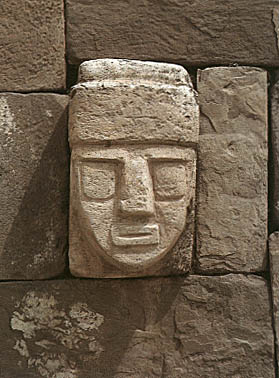
According to
him the large monolithic Sun Gate of Tiahuanaco was
evidently originally the centerpiece
of the most important part of the
so-called Kalasasaya, the huge
chief temple of Tiahuanaco. Its upper part
is covered with a stupendously
intricate sculpture in flat bas relief.
This has been described
as a "calendar" almost as long as the monolithic
gateway has been known to exist;
thus the Sun Gate has also been called
"the Calendar Gate. This calendar
sculpture, though it undoubtedly depicts
a "solar year," cannot however
be made to fit into the solar year as we
divide it at present. After many
futile attempts had been made, by employing
a Procrustean chopping off of toes
or heels to make the calendar work, the
sculpture-which indeed has a highly
decorative aspect-was eventually
declared generally to be nothing
but an intricate piece of art.
(See Arturo Posnansky and F. Buck.)
Professor Schindler-Bellamy
and the American astronomer Allen have
nevertheless continued to insist
the sculpture was a calendar, though one of
a special kind, designed
for special purpose, and, of course, for a special
time. Hence it must refer exclusively
to the reckoning of that time, and to
certain events occurring then.
Consequently we cannot make the calendar
"speak" in terms of our own time,
but let it speak for itself—and listen to
what it says and learn from
it. When we do so we gain an immense insight
into the world of the people of
that era, into the manner of thinking of
their intellectuals, and generally
into the way their craftsmen and laborers
lived and worked.
To describe these things in
detail would make a long story; it took
l)r. Allen and Professor Schindler-Bellamy
and their helpers many years of
hard work to puzzle out the Tiahuanaco
system of notation and its symbology,
and to make the necessary
calculations (before the age of computers). The
result was a book of over 400 pages,
The Calendar of Tishuanaco, published
in 1956.
Thorough analysis of the Sun
(Sate sculpture revealed the astonishing
fact that the calendar is
not a mere list of days for the "man in the
street" of the Tiahuanaco
of that time, telling him the dates of market
days or holy days; it is actually,
and pre-eminently a unique depository of
astronomical, mathematical,
and scientific data- the quintessence of the
knowledge of the bearers of Tiahuanacan
culture.
The enormous amount of information
the calendar has been made to
contain-and to impart to anyone
ready and able to read it is communicated in
a way that is, once the system
of notation has been grasped, singularly
lucid and intelligible, "counting
by units of pictorial or abstract form.
The different forms of those
units attribute special, very definite and
important additional meanings to
them, and make them do double or multiple duty. By means of that method
"any number" can be expressed without employing definite "numerals"
whose meaning might be difficult, if not impossible, to establish. It is
only necessary to recognize the units and consider their forms, and
find their groupings, count them out, and render the result in our
own numerical notation.
Some of the results seem to
be so unbelievable that superficial
critics have rejected them as mere
arrant nonsense. But they are too well
dove-tailed and geared into
the greater system (and in some cases supported by peculiar repetitions
and cross-references) to be discarded in disgust; one has to accept them
as correct. Whoever rejects them, however, also accepts the onus of offering
a better explanation, and Professor Schindler-Bellamy has the "advantage
of doubt," at any rate.
The "solar
year" of the calendar's time had very practically the
same length as our own, but, as
shown symbolically by the sculpture, the
earth revolved more quickly then,
making the Tiahuanacan year only 290 days, divided into 12 "twelfths"
of 94 days each, plus 2 intercalary days. Tilese groupings (290,
24, 12, 2) are clearly and unmistakably shown in the
sculpture. The explanation of 290
versus 3651/4 days cannot be discussed
here.
At the time Tiahuanaco flourished
the present moon was not yet
the companion ol our earth but
was still an independent exterior planet.
There was another satellite moving
around our earth then, rather close-5.9
terrestrial radii, center to center;
our present moon being at 60 radii.
Because of its closeness it moved
around the earth more quickly than our
planet rotated. Therefore it rose
in the west and set in the east (like Mars'
satellite Phobos), and so
caused a great number of solar eclipses, 37 in
one "twelfth," or 447 in one "solar
year " of course it caused an equal
number of satellite eclipses. These
groupings (37, 447) are shown in the
sculpture, with many Corroborating
cross-references. Different symbols show
when these solar eclipses,
which were of some duration, occurred: at
sunrise, at noon, at sunset.
These are only a small sample
of the exact astronomical information
the calendar gives. It also
gives the beginning of the year, the days of the
equinoxes and solstices,
the incidence of the two intercalary days,
information on the obliquity
of the eliptic (then about 16.5 degrees; now
23.5) and on Tiahuanaco's latitude
(then about 10 degrees; now 16.27), and
many other astronomical and
geographical references from which interesting and important data
may be calculated or inferred by us. Tiahuanacan scientists certainly knew,
for instance, that the earth was a globe which rotated on its axis
(not that the sun moved over a flat earth), because they calculated
exactly the times of eclipses not visible at Tiahuanaco but visible
in the opposite hemisphere (One wonders whether they were actually
able to travel around the world, and speculate in what sort of vessel !
)
A
few more facts revealed in the calendar are both interesting and
surprising As indicated by an arrangement
of "geometrical" elements we can
ascertain that the Tiahuanacans
divided the circle factually astronomically,
but certainly mathematically}
into 264 degrees (rather than 360). Also,
they determined-ages before Archimedes
and the Egyptians the ratio of pi,
the most important ratio
between the circumference of the circle and its
diameter, as 22/7, or, in our notation,
3.14+. They could calculate squares
(and hence, square roots).
They knew trigonometry and the measuring of angles (30, 60, 90 degrees)
and their functions- They could calculate and indicate fractions,
but do not seem to have known the decimal system nor did they apparently
ever employ the duodecimal system though they were aware of it. (For
a still unknown reason, however, the number 11 and its multiples occur
often.) They were able to draw absolutely straight lines and exact right
angles, but no mathematical instruments have yet been found.
We
must take notice of the evident parallels with the markings of
the Nasca Plain. We do not know
the excellent tools they must have used for
working the glass-hard andesite
stone of their monuments, cutting, polishing,
and incising. They must have
employed block and tackle for lifting and
transporting great loads (up to
200 tons) over considerable distances and
even over expanses of water from
the quarries to the construction sites.
It is difficult to see how
all the calculations, planning, and
designwork involved in producing
the great city of Tiahuanaco could have
been done without some form of
writing, and without a system of notation
different from the "unit" system
of the calendar sculpture. If they had
such a system they must have used
it only on perishable materials. (One is
Lempted to think all these Nasca
markings had been constructed by Atlanteans who fled to the altiplano before
or after the destruction of their island continent 12,000 years ago.)
I have so far dealt with some
of the aspects of the Tiahuanacan
world, namely those connected with
the calendar as a monument of what
Schindler-Bellamy describes as
"fossilized science." But the calendar
science-sculpture, and similar
slightly older ones also found at the site,
must also be regarded and appreciated
from an aesthetic point of view, a
great artistic achievement in design
and execution-and an absolute
masterpiece of arrangement and
layout.
The most
tantalizing fact of all is that the Tiahuanaco culture has
no roots in that area. It did not
grow there from humbler beginnings, nor is
any other place of origin known.
It seems to have appeared practically full
blown suddenly. Only a few "older"
monuments, as can be inferred from the
"calendrical inscriptions" they
bear, have been found, but the difference in
time cannot have been very
great. The different-much lower cultures
discovered at considerable distances
from Tiahuanaco proper, addressed as
"Decadent Tiahuacan" or as "Coastal
Tiahuanaco," are only very indirectly
related to the culture revealed
by the Calendar Cate. Some of their painted
symbols are somehow somewhat
related to the calendar symbols, but they make no sense whatever; they
are, if anything, purely ornamental
Tiahuanaco apparently remained
for only a very short period at its
acme of perfection (evidenced by
the Calendar Gate) and perished suddenly,
perhaps through the cataclysmic
happenings connected with the breakdown of the former "moon." We
have at present no means of determining when Tiahuanaco rose to supreme
height. or when its culture was obliterated, asn naturally, the calendar
itself can tell us nothing about that. It will certainly not have
been in the historical past but well back in the prehistoric. It must
indeed have occurred before the
planet Luna was captured as the earth's
present moon, about 12,000 years
ago.
The
capture of the satellite and its later fall to the surface on
our planet imposed great stresses
on the earth. The gravitational pull
caused floods and earthquakes until
the moon settled into a stable orbit
one-fift}l of today's distance.
Hence the "moon" draws the oceans into a
belt or bulge around the equator,
drowning the equatorial region but leaving
the polar lands high and dry. When
the satellite approached within a few
thousand miles gravitational forces
broke it up; according to the Roche
formula each planetoid or asteroid
disintegrates when approaching the
critical distance of 50 to 60,000
kms. The fragments shattered down on
earth; the oceans, released from
the satellite's gravity, flowed back
toward the continents, exposing
tropical lands and submerging polar
territories. This is the simple
explanation of the Horbiger theory, and it
seems to me the most logical one.
Thus the approach of the "moon" caused a world-wide deluge, effecting
changes of climate and provoking
earthquakes accompanied by volcanic
eruptions. The "ring" left by the
satellite after breaking into fragments
caused a sudden drop in temperature
of at least 20 degrees, which
geologists recognize as iia decline"
in temperature. It is evident, for
example, in the discovery of frozen
mammoths in the Siberian tundra.
Possibly gravity-and therefore
physical weight—was also changed on earth,
and with it biological growth:
this would explain the widespread
construction of huge megalithic
monuments as well as the presence of
giants-man and animal-in fossil
strata, tombs, and myths. According to
Horbiger four moons fell on earth,
producing four Ice Ages; our present
moon, the fifth one, will similarly
be drawn into the critical configuration
of one-fifth of its present distance
(380,000 kms.) and will cause the
fifth cataclysm. (Remember the
Aztec calendar's prediction of doomsday by
earthquake!)
The
theory of a falling moon has recently been substantiated by Dr.
John O'Keefe, a scientist at the
Coddard Laboratory for Astronomy in
Maryland. Dr. O'Keefe claims that
the fragments of a moon's collision
formed a ring around our planet
that could have kept the sun's rays from
penetrating to earth, thus causing
world-wide decline of temperatures.
After a while the fragments
showered down on earth, breaking into
smithereens known as tectites.
These tectites O'Keefe believes were
fragments of the fallen moon, thus
proving Horbiger 's "World-lce-Cosmology."

The record nevertheless shows
that a far-advanced culture made a
substantial attempt to plant its
society at Tiahuanaco, wanting to revitalize
this region which had already
been devastated by floods caused by the close
satellite. Their attempt
eventually miscarried, because they had
underestimated certain dangerous
developments that ultimately happened
contrary to all expectations and
calculations. Such world-wide cataclysms
appear in myth, in the Egyptian
Papyrus Ipuwer ("The sun set where it rose")
or the tomb of Senmut (showing
Orion-Sirius painted in reverse position),
or in the Finnish Kalevala ("the
earth turned round like a potter's wheel"),
or the Popol Vuh (describing fire
showering down from heaven)—all of which
indicate that our planet more than
once has suffered world-wide catastrophe.
REFERENCES
The Calendar of Tiahuanaco. London:
Faber, 1956.
The Moon 's Myths and Man. London:
Faber.
Theldol of Tiahtxanaco. London:
Faber, 1959.
The Atlantis Myth. London: Faber,
1948.
Articles from Catastrophism And Ancient History
are brought to you by The Thule Foundation